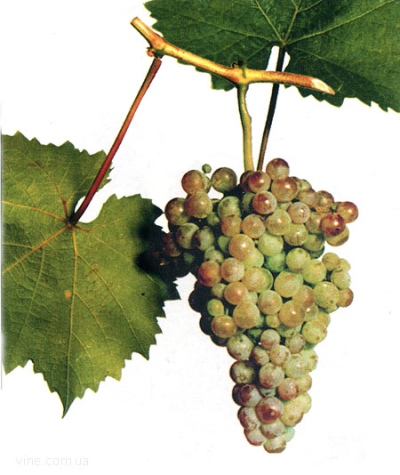
- Authors: I. Filippenko and L. T. Shtin (VNIIGiSPR Michurina, TsGL)
- Berry color: golden, turning pink on the sunny side
- Taste: harmonious
- With bones: No
- Ripening period: very early
- Frost resistance, ° C: -26
- Flower type: bisexual
- Density of the bunch: loose
- Skin: medium, torn
- Appeared when crossing: Dawn of the North x Black Kishmish
Korinka Russkaya is a grape variety with excellent frost resistance, good immunity and excellent taste. The plant is in the state register for the Central Black Earth Region.
Breeding history
The variety was bred at VNIIGiSPR Michurin, TsGL. The selection was carried out by I. M. Filippenko and L. T. Shtin. Initially, they set the task of obtaining a product with high winter hardiness. Breeders have achieved their goal using the parental pair of varieties Zarya Severa and Kishmish black. They obtained a species that can withstand frosts down to -26 degrees.
Geography of distribution
Due to their qualities and unpretentiousness, grape bushes are successfully grown in the central part of Russia, in the south and north-west of the country, in the Far East and in Siberia. The hybrid takes root no less productively in Poland, Belgium, Canada and the Baltic countries.
Description
The bushes of this variety are strong and vigorous, with developed roots and an intensive growth rate. They can be up to 3 m in height. Shoots of light brown shades, strong, perfectly ripening, capable of holding solid bunches. The leaves are large, with five lobes, poorly dissected, rich green color, with little pubescence. The flowers are white, with panicle-shaped inflorescences. The grapes bloom in May, for about two weeks. Fruits appear 2-3 years after planting.
The length of the shoots varies within 2-3 m. The degree of maturation of the vine varies in the range of 70-85% of its length. The yield level is significant. Fruit transportability is satisfactory. The variety is used to make high quality wine, raisins. There is no peeling of berries.
Ripening period
Korinka Russkaya belongs to very early varieties. Fruits ripen in July. But their full maturity occurs in the third decade of August. It is at this time that they usually begin to collect fruits. Brushes can be stored for a long time on the bushes without losing their properties and excellent appearance, gaining a significant amount of sugar. When grown in open northwest areas, harvesting starts in mid-September.
Bunches
Russian corinka forms clusters of medium size and weighing 180-250 g. The brushes have a conical, often winged shape. Their density is loose.
Berries
The berries are small, round, 8x10 mm in size and weighing up to 2 g, golden yellow shades. In sunny places, they acquire pinkish tones.
The contents are characterized by a fleshy and juicy consistency with pleasant taste properties. There is no obvious aroma. The skin is medium in thickness, not very strong. Seeds are missing. Sugar content varies in the range of 20-22%, but sometimes reaches high values. The acidity parameters are excellent and reach 5 g / l.
Taste
The fruit has a harmonious, intense grape taste, without other aftertastes. The tasting indicator is 4.3 points.
Yield
The variety has a stable and rich yield. Bears fruit in the second year of growth. With satisfactory care, up to 12 kg of fruits are harvested from the bush. Up to 80 centners per hectare.


Growing features
The culture is undemanding to the soil and does not need exceptional care. Perfectly cultivated by beginners.
Landing
Basic recommendations for landing:
- the selected seedlings are subject to careful study to identify possibly drying out roots, damaged or diseased shoots;
- seedlings should be rejuvenated by pruning roots and shoots;
- preparation of recesses for planting is carried out in advance;
- in the case of proximity to groundwater, the pits are drained;
- when loading the pit by 1/3 with nutrient soil, the roots should be protected from the direct effect of fertilizers by adding simple soil.

Pollination
The vine has both female and male flowers. In other words, it is a self-pollinated variety. There is no need for pollinators.
Pruning
Pruning is recommended for 6-8 buds. In the spring, they must do sanitary pruning, removing non-viable branches.



Frost resistance and the need for shelter
Korinka Russkaya is a frost-resistant variety, but in snowless and too cold winters it needs to be covered with agrofibre or similar materials.

Diseases and pests
The culture has an average degree of resistance to diseases and pests, the risks of disease occurrence are real. Grapes are susceptible to powdery mildew, and can also be affected by mildew.
The vine is most intensely affected by heavy rains during fruit ripening. They love to feast on wasps and birds. To protect the harvest, the bunches are covered with special bags that block the path of pests to the berries.

If a grape is exposed to any disease or insect, this always affects its appearance.
Storage
The fruits of Korinka Russkaya are well stored in the refrigerator, as well as when transported over long distances. They can also be stored in a cool and ventilated area.











































































